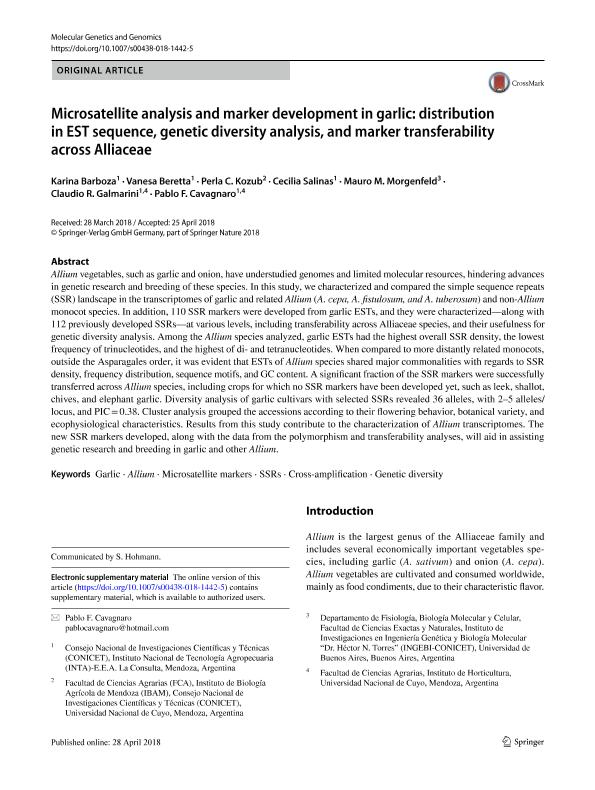Artículo
Microsatellite analysis and marker development in garlic: distribution in EST sequence, genetic diversity analysis, and marker transferability across Alliaceae
Barboza Rojas, Karina ; Beretta, Hebe Vanesa
; Beretta, Hebe Vanesa ; Kozub, Perla Carolina
; Kozub, Perla Carolina ; Salinas Palmieri, María Cecilia
; Salinas Palmieri, María Cecilia ; Morgenfeld, Mauro Miguel
; Morgenfeld, Mauro Miguel ; Galmarini, Claudio Romulo
; Galmarini, Claudio Romulo ; Cavagnaro, Pablo Federico
; Cavagnaro, Pablo Federico
 ; Beretta, Hebe Vanesa
; Beretta, Hebe Vanesa ; Kozub, Perla Carolina
; Kozub, Perla Carolina ; Salinas Palmieri, María Cecilia
; Salinas Palmieri, María Cecilia ; Morgenfeld, Mauro Miguel
; Morgenfeld, Mauro Miguel ; Galmarini, Claudio Romulo
; Galmarini, Claudio Romulo ; Cavagnaro, Pablo Federico
; Cavagnaro, Pablo Federico
Fecha de publicación:
10/2018
Editorial:
Springer Heidelberg
Revista:
Molecular Genetics And Genomics
ISSN:
1617-4615
e-ISSN:
1617-4623
Idioma:
Inglés
Tipo de recurso:
Artículo publicado
Clasificación temática:
Resumen
Allium vegetables, such as garlic and onion, have understudied genomes and limited molecular resources, hindering advances in genetic research and breeding of these species. In this study, we characterized and compared the simple sequence repeats (SSR) landscape in the transcriptomes of garlic and related Allium (A. cepa, A. fistulosum, and A. tuberosum) and non-Allium monocot species. In addition, 110 SSR markers were developed from garlic ESTs, and they were characterized—along with 112 previously developed SSRs—at various levels, including transferability across Alliaceae species, and their usefulness for genetic diversity analysis. Among the Allium species analyzed, garlic ESTs had the highest overall SSR density, the lowest frequency of trinucleotides, and the highest of di- and tetranucleotides. When compared to more distantly related monocots, outside the Asparagales order, it was evident that ESTs of Allium species shared major commonalities with regards to SSR density, frequency distribution, sequence motifs, and GC content. A significant fraction of the SSR markers were successfully transferred across Allium species, including crops for which no SSR markers have been developed yet, such as leek, shallot, chives, and elephant garlic. Diversity analysis of garlic cultivars with selected SSRs revealed 36 alleles, with 2–5 alleles/locus, and PIC = 0.38. Cluster analysis grouped the accessions according to their flowering behavior, botanical variety, and ecophysiological characteristics. Results from this study contribute to the characterization of Allium transcriptomes. The new SSR markers developed, along with the data from the polymorphism and transferability analyses, will aid in assisting genetic research and breeding in garlic and other Allium.
Palabras clave:
ALLIUM
,
CROSS-AMPLIFICATION
,
GARLIC
,
GENETIC DIVERSITY
,
MICROSATELLITE MARKERS
,
SSRS
Archivos asociados
Licencia
Identificadores
Colecciones
Articulos(CCT - MENDOZA)
Articulos de CTRO.CIENTIFICO TECNOL.CONICET - MENDOZA
Articulos de CTRO.CIENTIFICO TECNOL.CONICET - MENDOZA
Articulos(IBAM)
Articulos de INST.DE BIOLOGIA AGRICOLA DE MENDOZA
Articulos de INST.DE BIOLOGIA AGRICOLA DE MENDOZA
Articulos(INGEBI)
Articulos de INST.DE INVEST.EN ING.GENETICA Y BIOL.MOLECULAR "DR. HECTOR N TORRES"
Articulos de INST.DE INVEST.EN ING.GENETICA Y BIOL.MOLECULAR "DR. HECTOR N TORRES"
Citación
Barboza Rojas, Karina; Beretta, Hebe Vanesa; Kozub, Perla Carolina; Salinas Palmieri, María Cecilia; Morgenfeld, Mauro Miguel; et al.; Microsatellite analysis and marker development in garlic: distribution in EST sequence, genetic diversity analysis, and marker transferability across Alliaceae; Springer Heidelberg; Molecular Genetics And Genomics; 293; 5; 10-2018; 1091-1106
Compartir
Altmétricas



